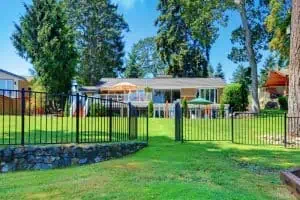How to Use Metal Fencing on a Hill?
If you have a hill or slope in your yard, it can be difficult to decide how best to fence it. But if you use the right type of fencing, you can create an attractive, durable fence that protects your property while also providing privacy and security.
(Looking for “Fence Repair Services“? Contact us today!)

One of the most common types of fencing for sloping yards is metal. This type of fencing is available in both solid and hollow steel and is a cost-effective way to enclose your yard.
Unlike wood, metals don’t rot or decay easily, and they don’t need to be repaired when they get scratched or rusty. However, if you don’t have the skills to install a metal fence yourself, consider hiring a professional.
The first step in installing a metal fence on a hill is to measure the height of the slope. To do this, drive a 2-foot stake into the ground at the top of the slope and another at the bottom. Run a level mason’s line between the two stakes and mark equal spaces for fence posts along the line.
Now that you’ve identified the slope, it’s time to plan for your fence. Depending on the style of fence you want, you can either follow the contour of your hill or create a stepped fence.
If you’re using a contour fence, follow the natural contour of the slope with fence posts spaced evenly along the rails. This is a great option if you don’t want to alter your landscape, and will be more resistant to erosion than a stepped fence.
A stepped fence, on the other hand, steps down the slope in a series of steps. This style of fence is great for sloping areas but can look messy if it’s not planned well.
With a stepped fence, you will need longer fence posts than you would with a contour fence. This is because the length of each picket will be different on each panel as you move down the fence. This is why many people choose to put paving stones, bricks, or cinder blocks beneath the lower end of their stepped fence.
Next, you’ll need to dig holes for each post and set them in place. This will take a lot of time, but it’s worth it for the peace of mind and aesthetics that a stepped fence can provide.
Once your fence posts are in place, you can begin attaching the fence panels to them. Most fence suppliers offer a variety of pre-fab or do-it-yourself kits for this process.
For a DIYer, it’s possible to assemble and install an aluminum or steel fence on your own, but you’ll need to invest in equipment like a post-hole digger and a cement footing. This can add up quickly, and a professional will probably charge more than you’ll pay to install the fence yourself.
The other option is to use a metal fence that can be angled to fit your hill’s gradient. This requires a little more work, but at FenceCorp we’ve installed hundreds of fences on sloping land and know which fencing products will suit your slope’s gradient.

